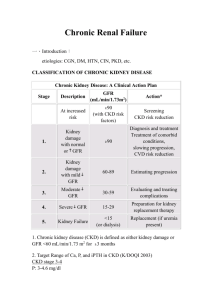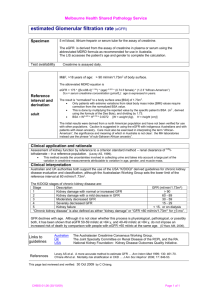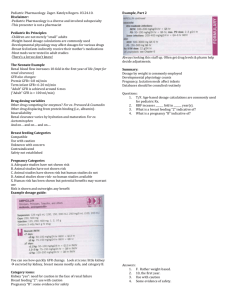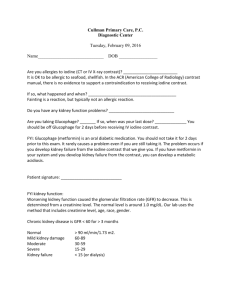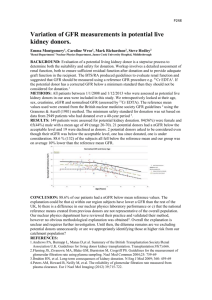Stage 1
advertisement
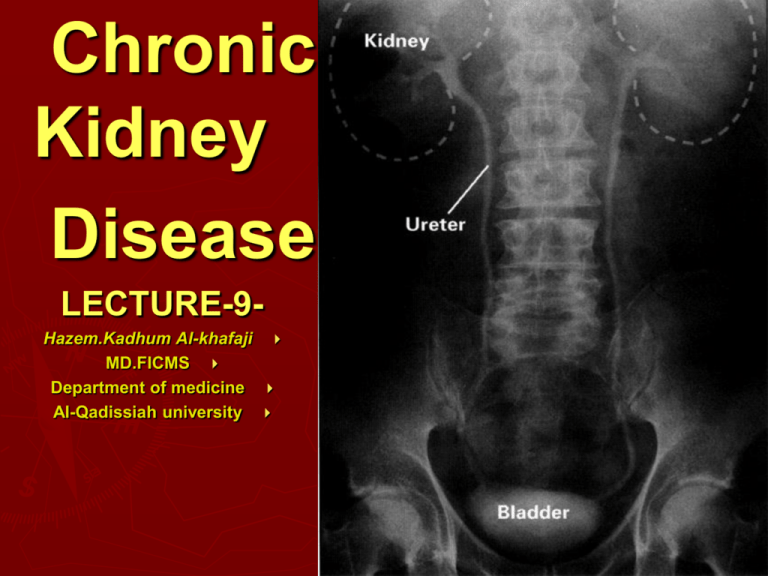
Chronic Anatomy Kidney Disease LECTURE-9Hazem.Kadhum Al-khafaji MD.FICMS Department of medicine Al-Qadissiah university What is CKD? Presence of markers of kidney damage for three months, as defined by structural or functional abnormalities of the kidney with or without decreased GFR, manifest by either pathological abnormalities or other markers of kidney damage, including abnormalities in the composition of blood or urine, or abnormalities in imaging tests. The presence of GFR <60 ml/min/1.73 m2 for three months, with or without other signs of kidney damage. Am J Kidney Dis 2002; 39:S1 Definition of Chronic Kidney Disease Chronic kidney disease is defined as either kidney damage or GFR < 60 cc/min/1.73m2 for ≥ 3 months. Kidney damage is defined as pathologic abnormalities or markers of damage, including abnormalities in blood or urine tests or imaging NKF/KDOQI Clinical Practice Guidelines for Chronic Kidney Disease General definitions Azotemia - elevated blood urea nitrogen (BUN >28mg/dL) and creatinine (Cr>1.5mg/dL) Uremia - azotemia with symptoms or signs of renal failure End Stage Renal Disease (ESRD) - uremia requiring .1 transplantation or dialysis Chronic Renal Failure (CRF) - irreversible kidney dysfunction with azotemia >3 months Creatinine Clearance (CCr) - the rate of filtration of creatinine by the kidney (GFR marker) Glomerular Filtration Rate (GFR) - the total rate of filtration of blood by the kidney Epidemiology Chronic Kidney Disease in the USA 20 million Americans have CKD( 1 in 8 people) Approx 435,000 have ESRD/HD Annual mortality rate for ESRD: 24% 20 million others are at risk Hypertension & Diabetes are the leading causes of kidney failure 23% of all Americans have hypertension 16 million Americans have diabetes Incidence • There are about 50,000 cases of ESRD per year. Diabetes: most common cause ESRD (risk 13x ) Over 30% cases ESRD are primarily to diabetes pathophysiology 1 million nephrons in each kidney. Destruction of part of these nephrons leads to componsatory hypertrophy & hyperfiltration of remaining nephrons –--> increased glomerular capillary pressure & evantually sclerosis of these glomeruli. Factors causing progressive renal injury 1- systemic hypertension 2- Proteinuria 3- Increased renal amoniogenesis 4- Hyperlipidaemia 5- Hyperphosphataemia with Calcium phosphate deposition 6- Decrease level of nitrous oxide 7- Smoking What stage of CKD now? Although, the stages are generally progressive but we & the patient can impact or slow the progression of kidney disease with diet, medications and healthy behaviors. Stage 1 – GFR ≥ 90 cc/min/1.73m2 Kidney Damage with normal or high GFR Stage 2 – GFR – 60 to 89 cc/min/1.73m2 Kidney Damage with mildly decreased GFR Stage 3 – GFR – 30 to 59 cc/min/1.73m2 Moderate decreased GFR Stage 4 – GFR – 15 to 29 cc/min/1.73m2 Severely decreased GFR Stage 5 – GFR - < 15 cc/min/1.73m2 Kidney failure NKF/KDOQI Clinical Practice Guidelines for Chronic Kidney Disease Aetiology 1- diabetes mellitus(20-40%) 2- Hypertensive renal diseases 3- Primary renal diseases such as G.N 4- Secondary renal diseases such as SLE. 5- tubulo-interstitial nephritis. 6- poly cystic kidneys. 7- renal artery stenosis 8- Pyelonephritis 9- Undetermined cause(5-20%) Symptoms and Signs of Early Stages of CKD Most patient in stage 1- 3 a symptomatic There may be general non specific signs & symptoms as Weakness Decreased appetite & Nausea Changes in urination (nocturia, polyuria, frequency) Nocturia may be the earliest feature of CKD. Blood in urine or dark-colored urine Foamy urine Loin pain oedema Elevated blood pressure Pale skin Symptoms and Signs of Late (Uremic) Stages of CKD General ( lassitude , fatigue , elevated blood pressure , signs of volume overload , decreased mental acuity , intractable hiccups , uremic fetor ) Skin (sallow appearance, earthy coulored, pruritic excoriations ) Pulmonary ( dyspnoea , pleural effusion , pulmonary edema , uremic lung ) Cardiovascular ( pericardial friction rub , congestive heart failure ) Gastrointestinal ( anorexia , nausea , vomiting , weight loss , stomatitis , unpleasant taste in the mouth ) Neuromuscular ( muscular twitches , peripheral sensory and motor neuropathies , muscle cramps , restless legs , sleep disorders , hyperreflexia , seizures , encephalopathy , coma ) Endocrine-metabolic ( decreased libido , amenorrhea , impotence ) Hematologic ( anemia , bleeding diathesis ) Metabolic changes: 1- Acidosis,the patient breathing deep & slow. 2- Hypocalcaemia. 3- Hyperphosphataemia. 4- Hypomanasaemia. 5- Hyperparathyroidism(secondary&tertiary) 6- Renal osteodystrophy: osteomalacia,osteoporosis,fibrosing osteitis cystica. Electrolyte Abnormalities Excretion of Na+ is initially increased, .1 probably due to natriuretic factors Maintain volume until GFR <10- .a 20mL/min, then oedema 3. Tubular K+ secretion is decreased.Hyperkalaemia is the most dangerous complication. Assessment and Diagnostic Findings Glomerular filtration rate: GFR (see next slide) is • decreased resulting in a decrease in creatinine clearance, whereas the serum creatinine and BUN levels increase. Serum creatinine is the more sensitive indicator of renal function because of its constant production in the body.. Sodium and water retention: In ESRD, some • patients retain sodium and water, increasing the risk for edema, heart failure, and hypertension. Other patients may lose salt and run the risk of developing hypotension and hypovolemia. Calculations Cockcroft-Gault CrCl (mL/min) = (140 - age) x wt kg) Men: SCr(mg/dl) x 72 Women: multiply by 0.85 Serum creatinine has a drawback in the measurement of glomerular filtration rate (GFR) in that it may vary according to muscle mass & may be influeced by proteinous meal. What is the alternative? Thank you Next lecture Management of CKD

